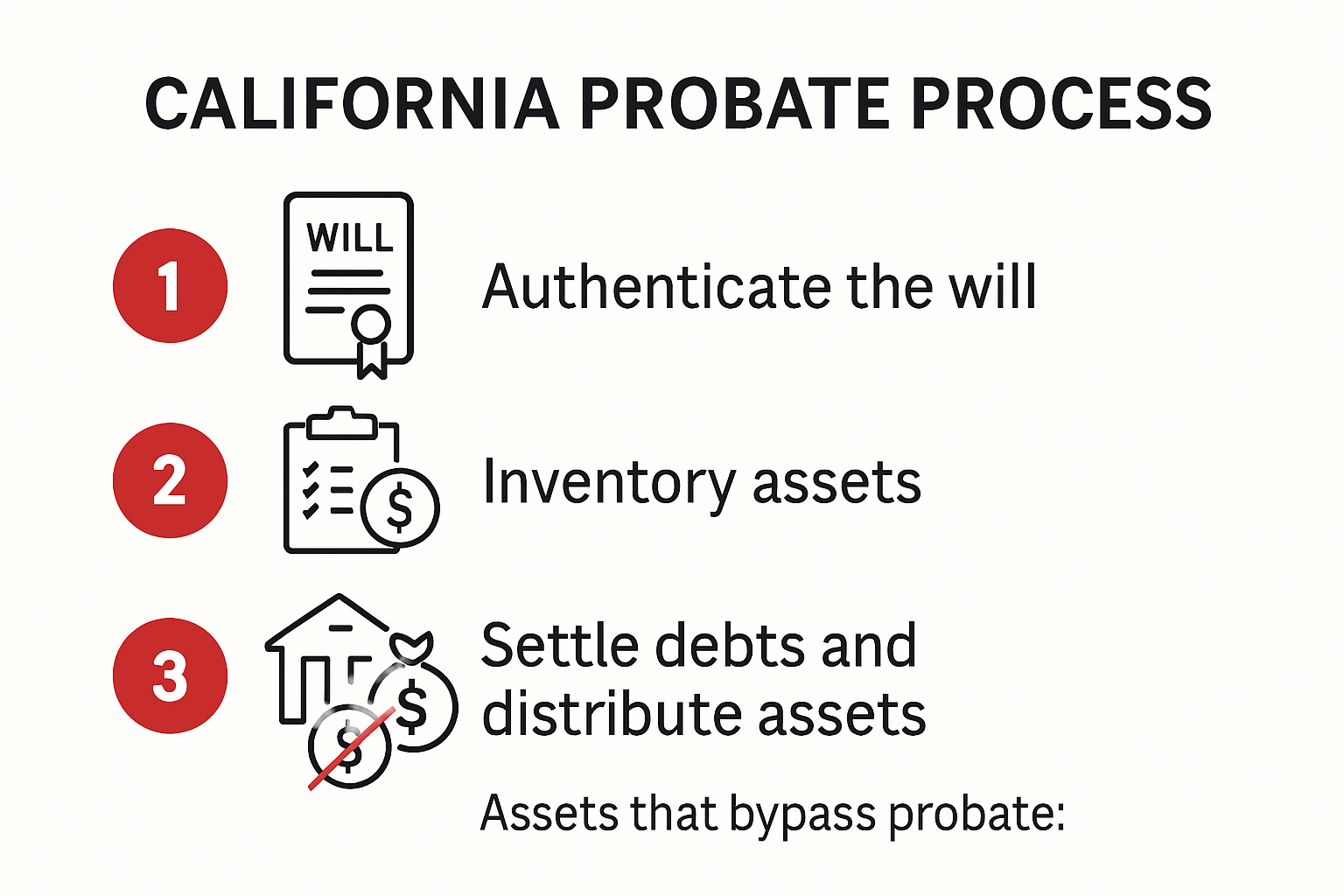
PARENTS & HOMEOWNERS: MY 7-STEP ESTATE PLANNING PROCESS WILL PROTECT YOUR HEIRS
From Creditors, Predators & Bad Choices, And Will Help You Become a (Bigger) Hero to Your Family!



California Probate Process Explained: 2025 Guide for Families and Homeowners
{
“@type”: “Article”,
“author”: {
“url”: “https://ridleylawoffices.com”,
“name”: “Ridley Law Offices”,
“@type”: “Organization”
},
“@context”: “https://schema.org”,
“headline”: “California Probate Process Explained: 2025 Guide for Families and Homeowners”,
“publisher”: {
“url”: “https://ridleylawoffices.com”,
“name”: “Ridley Law Offices”,
“@type”: “Organization”
},
“inLanguage”: “en”,
“articleBody”: “Discover the california probate process explained step-by-step for families, property owners, and executors. Protect your loved ones and assets in 2025.”,
“description”: “Discover the california probate process explained step-by-step for families, property owners, and executors. Protect your loved ones and assets in 2025.”,
“datePublished”: “2025-07-08T01:08:15.222Z”,
“mainEntityOfPage”: {
“@id”: “https://ridleylawoffices.com/california-probate-process-explained-2025-guide”,
“@type”: “WebPage”
}
}

California probate can feel like a maze, especially with families facing estates that sometimes require court approval for values as low as $166,250. Most people expect the process to be a simple handoff, guided only by a will. Surprisingly, families can be tangled up for months or even years, and the smallest mistakes by an executor can lead to personal legal trouble—not just paperwork headaches. Here is what really shapes the outcome, and why skipping proactive prep may cost far more than you think.
Table of Contents
- What Is Probate In California?
- Step-By-Step Breakdown Of The Probate Process
- Protecting Your Family And Assets From Common Pitfalls
- Reducing Delays And Costs: Proactive Estate Planning Tips
Quick Summary
| Takeaway | Explanation |
|---|---|
| Understanding Probate | Probate is a court-supervised process that ensures a deceased person’s assets are distributed according to their will, while also managing debts and taxes. Not all assets require probate, such as joint tenancy assets and living trusts. |
| Step-by-Step Process | The probate process involves filing a petition, inventorying assets, settling debts, and distributing property. Each step requires strict adherence to legal requirements and may take several months to over a year to complete. |
| Common Pitfalls | Executors must avoid errors like incomplete asset documentation and failing to notify creditors, as these can lead to personal liability and complications in the estate settlement. |
| Proactive Estate Planning | Families can reduce probate delays and costs by using strategies such as revocable living trusts, joint tenancy ownership, and maintaining up-to-date documentation and communication with beneficiaries. |
| Advanced Techniques | Implementing advanced planning methods, such as irrevocable trusts and tax-efficient wealth transfer strategies, can help protect assets from creditors and streamline the distribution process. |
What Is Probate in California?
Probate in California represents a crucial legal process that determines how a deceased person’s assets are distributed and managed after their passing. This complex judicial procedure ensures that estate matters are handled systematically, protecting the rights of heirs, creditors, and beneficiaries.
Understanding the Probate Landscape
At its core, probate is a court supervised method of transferring property after someone dies. In California, the process involves authenticating the deceased’s will, inventorying their assets, paying outstanding debts and taxes, and ultimately distributing remaining property to rightful heirs. Learn more about our comprehensive estate management approach.
According to the California Courts Self Help Center, not all assets require probate. Certain properties can bypass this legal process, including:
- Joint Tenancy Assets: Property owned jointly automatically transfers to the surviving owner
- Payable on Death Accounts: Financial accounts with designated beneficiaries
- Living Trust Properties: Assets held in properly structured trusts

California Probate Thresholds and Procedures
California offers simplified procedures for smaller estates. Nolo Legal Research reveals that estates valued under $166,250 can use an expedited process called the Small Estate Summary Procedure. This streamlined approach allows families to claim assets with minimal court intervention.
The probate process typically involves several critical steps. An executor named in the will or an administrator appointed by the court manages the estate. Their responsibilities include filing the will with the probate court, notifying beneficiaries, inventorying assets, paying debts, and distributing remaining property. This process can take anywhere from several months to over a year, depending on the estate’s complexity and potential disputes.
For California families, understanding probate is more than a legal formality. It represents a critical pathway to preserving family wealth, resolving potential conflicts, and ensuring that a loved one’s final wishes are respected and implemented. While the process can seem overwhelming, professional guidance can transform what appears to be a complex legal maze into a manageable and structured journey of estate resolution.
To clarify the types of assets that may or may not require probate in California, the following table summarizes asset categories and their typical probate requirements:
This table compares common asset types and whether they bypass probate, as discussed above.
| Asset Type | Requires Probate? | Notes/Description |
|---|---|---|
| Joint Tenancy Assets | No | Automatically transfer to surviving owner |
| Payable on Death Accounts | No | Paid directly to named beneficiaries |
| Living Trust Properties | No | Held in trust, bypass probate process |
| Sole Ownership Real Property | Yes (unless in trust) | Typically subject to probate unless in a trust |
| Community Property w/o Right of Survivorship | Yes | Requires probate unless designated otherwise |
| Life Insurance with Beneficiary | No | Paid directly to beneficiary |
| Retirement Accounts with Beneficiary | No | Paid directly to beneficiary |
Step-by-Step Breakdown of the Probate Process
Navigating the California probate process requires a strategic approach and understanding of its intricate legal requirements. This comprehensive journey involves multiple critical stages that transform a deceased person’s estate into a legally resolved distribution of assets.
Initiating the Probate Proceedings
The probate process officially begins when a petition is filed with the Superior Court in the county where the deceased resided. Explore our detailed guide on estate settlement. According to the California Courts Self Help Center, this initial step involves submitting Form DE-111, which requests the court to appoint a personal representative responsible for managing the estate.
Key initial requirements include:
- Presenting the original will (if one exists)
- Providing a certified death certificate
- Identifying all potential heirs and beneficiaries
- Estimating the total value of the deceased’s assets
Asset Inventory and Valuation
Once the court appoints a personal representative, a comprehensive asset inventory becomes critical. Nolo Legal Research indicates that this phase involves meticulously documenting and appraising all estate assets, including real estate, financial accounts, personal property, and investments.
A court-appointed probate referee plays a crucial role during this stage. Their primary responsibility involves professionally assessing the market value of non-monetary assets, ensuring an accurate and fair valuation. This step is essential for determining potential estate taxes and equitable asset distribution.

Debt Settlement and Final Distribution
Before beneficiaries can receive their inheritance, all outstanding debts and taxes must be settled. The personal representative must notify creditors, pay valid claims, and file necessary tax returns. According to the IRS Guidelines, this might include filing a final income tax return and potentially an estate tax return.
After debt settlement, the personal representative prepares a final accounting report submitted to the court. This detailed document outlines all financial transactions, asset valuations, and proposed distributions. Upon court approval, assets are distributed to beneficiaries according to the will or state intestacy laws.
The entire probate process in California can range from several months to over a year, depending on the estate’s complexity, potential disputes, and court schedules. While challenging, understanding these steps empowers families to navigate this legal journey with confidence and clarity. Professional legal guidance can significantly streamline this process, reducing stress and potential complications during an already emotional time.
To enhance understanding, the following table presents an organized overview of the key steps in California probate, along with brief descriptions and typical timelines.
| Step | Description | Typical Timeframe |
|---|---|---|
| Filing Petition and Notifying Heirs | Official start; petition is filed, heirs notified | 1-2 months |
| Appointment of Personal Representative | Court appoints executor or administrator | 1-3 months |
| Inventory and Appraisal of Assets | Full inventory, professional valuation | 2-4 months |
| Notification and Payment to Creditors | Creditors are notified, debts settled | 4-6 months |
| Tax Filings and Payments | Final income and estate tax returns filed | 3-6 months |
| Final Accounting and Court Review | Court approves accounting and proposed distributions | 1-2 months |
| Distribution to Beneficiaries | Assets distributed as per will/intestacy law | 1-2 months (after approval) |
Protecting Your Family and Assets From Common Pitfalls
Navigating the probate process in California requires strategic planning and a proactive approach to prevent potential legal and financial complications. Understanding common pitfalls can help families protect their assets and minimize unnecessary stress during an already challenging time.
Critical Estate Management Errors
One of the most significant risks in probate involves improper asset management and documentation. Learn more about comprehensive asset protection to safeguard your family’s financial future. According to Von Rock Law, executors frequently encounter critical errors that can derail the estate settlement process.
Common management mistakes include:
- Incomplete Asset Documentation: Failing to create a comprehensive inventory of all assets
- Delayed Creditor Notifications: Not promptly informing potential creditors about the estate
- Improper Tax Handling: Mismanaging estate tax obligations and filing requirements
Legal and Financial Liability Risks
Executors bear significant fiduciary responsibilities that can expose them to personal legal and financial risks. Vista Legal Group highlights that mismanagement can result in personal liability for estate administrators. This includes:
Potential liability scenarios encompass:
- Premature distribution of assets before resolving outstanding debts
- Failure to maintain accurate financial records
- Improper valuation of estate properties
- Neglecting to file required court documentation
The Internal Revenue Service emphasizes the critical nature of precise tax reporting. Executors must file final income tax returns, estate tax returns, and ensure all tax obligations are meticulously addressed.
Strategies for Minimizing Probate Complications
Mitigating risks requires a comprehensive approach to estate planning and management. Professional legal guidance can significantly reduce potential complications. Key strategies include:
- Maintaining detailed and up-to-date documentation of all assets
- Consulting with experienced probate attorneys
- Creating clear communication channels among beneficiaries
- Conducting regular reviews of estate planning documents
- Implementing trusts to potentially bypass complex probate procedures
California families face unique challenges in estate management. The probate process can be intricate, with potential pitfalls that can quickly escalate into costly legal disputes. By understanding these risks and proactively addressing them, families can protect their assets, preserve their legacy, and ensure a smoother transition of wealth to future generations.
While the probate process may seem overwhelming, strategic planning and professional guidance can transform a potentially stressful experience into a manageable and structured approach to estate settlement. Investing time and resources in comprehensive estate planning is not just a legal necessity but a crucial step in protecting your family’s financial future.
Reducing Delays and Costs: Proactive Estate Planning Tips
Navigating the California probate process requires strategic foresight and proactive planning to minimize financial burdens and time-consuming legal procedures. By implementing targeted estate planning strategies, families can significantly reduce probate delays and associated costs.
Strategic Asset Positioning
Discover strategies to streamline your estate planning and protect your family’s financial future. According to the California Attorney General’s Office, several sophisticated techniques can help bypass traditional probate challenges.
Key asset positioning strategies include:
- Revocable Living Trusts: Enables direct asset transfer without court intervention
- Joint Tenancy Ownership: Facilitates immediate property transfer upon death
- Beneficiary Designations: Allows direct transfer of specific financial assets
Minimizing Probate Complexity
Effective estate planning involves understanding and strategically navigating potential complications. Top legal experts recommend several approaches to simplify the probate process:
- Maintaining comprehensive and updated asset documentation
- Regularly reviewing and updating estate planning documents
- Establishing clear communication channels with potential beneficiaries
- Creating precise instructions for asset distribution
The Internal Revenue Service emphasizes the importance of strategic tax planning. By carefully structuring asset transfers and understanding tax implications, families can minimize potential financial complications.
Advanced Planning Techniques
Proactive families can leverage advanced estate planning techniques to reduce probate complexities. These methods go beyond traditional will preparation and offer more nuanced asset protection:
- Establishing irrevocable trusts to protect assets from potential creditors
- Creating specific provisions for minor children or family members with special needs
- Implementing tax-efficient wealth transfer strategies
- Utilizing life insurance and retirement account beneficiary designations strategically
California residents face unique estate planning challenges, including complex property laws and significant potential tax implications. Professional legal guidance becomes crucial in navigating these intricate landscapes. By investing time and resources in comprehensive estate planning, families can transform a potentially stressful process into a structured, efficient approach to wealth transfer.
Ultimately, proactive estate planning is not just about legal documentation. It represents a profound commitment to protecting your family’s financial future, ensuring your legacy is preserved with minimal complications and maximum efficiency. The small investment in strategic planning today can save significant time, money, and emotional stress for your loved ones in the future.
Frequently Asked Questions
What is the California probate process?
Probate is a court-supervised procedure that manages the distribution of a deceased person’s assets, resolves debts and taxes, and ensures the intentions of the deceased, as stated in their will, are honored.
How long does the probate process take in California?
The probate process in California can take anywhere from several months to over a year, depending on the complexity of the estate and potential disputes among heirs and beneficiaries.
What assets do not require probate in California?
Assets such as joint tenancy properties, payable on death accounts, and living trust properties typically bypass the probate process in California, allowing for simpler transfer directly to beneficiaries.
How can I avoid common pitfalls in the probate process?
To avoid pitfalls, executors should maintain accurate and thorough asset documentation, notify creditors promptly, and consider consulting with an experienced probate attorney to ensure compliance with all legal requirements.
Ready to Simplify Probate and Protect Your Family’s Legacy?
Facing California probate can leave families feeling overwhelmed by lengthy court procedures, strict asset documentation, and constant fear of costly mistakes. The process discussed in this article highlights the risks of missing a single detail or failing to settle debts and taxes, which can result in unnecessary stress or even financial liability for the executor. If you want more than just guidance and need someone who knows the challenges of probate administration inside and out, our office is here to help.

You do not have to navigate complex probate steps alone. Real peace of mind comes from working with a legal partner who puts your interests first. Visit The Law Offices of Eric Ridley today to speak with a compassionate probate attorney and take action before complications or delays become a reality. If you want to avoid probate mistakes and secure your family’s assets for the next generation, now is the time to reach out.
Recommended
- Real Estate in Probate: California Planning Guide for Wealthy Families 2025 – Law Office of Eric Ridley
- A Step-by-Step Guide to Probate in California – Law Office of Eric Ridley
- Real Estate Probate Sales in California: How Families Secure Their Wealth (2025 Guide) – Law Office of Eric Ridley
- What Is Probate Litigation? A California Family Guide for 2025 – Law Office of Eric Ridley
- The Impact of California Laws on Estate Planning – Law Office of Eric Ridley
- Role of a Probate Attorney: Protecting California Families in 2025 – Law Office of Eric Ridley
